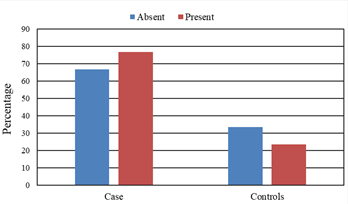Role of Iron Deficiency Anaemia as A Risk Factor for Wheeze Associated Respiratory Tract Infection in Children
Abstract
Introduction: Acute lower respiratory tract infections form a major portion of early childhood illnesses and infections. Iron deficiency anemia is an independent risk factor for lower respiratory tract infections (LRTI), however may also play an important role in wheeze associated respiratory tract infections. Wheezing is common in children with cumulative prevalence of almost 50% by the age of 6 yrs. Objective: To assess the role of iron deficiency anemia as a risk factor for wheeze associated respiratory tract infection in children. Methods: This case control study was conducted at Department of Pediatrics, Rajshahi Medical College Hospital, Rajshahi, Bangladesh from January to June 2022. Total 60 patients from both groups were included in our study. Among children six months to five years and having ≥2 episodes of wheeze associated respiratory tract infections. The clinical presentation and laboratory profile were recorded on a predesignated proforma. Iron deficiency anemia was diagnosed by hemoglobin <11.0 gm%, serum ferritin<12 ng/ml and RDW>15%. The statistical analysis was done using SPSS, Version 21. Results: A total of 60 children were enrolled in the study, of which 30 were cases and 30 were matched controls. Majority of subjects in both groups were male (n=19;63.3%), with male to female ratio of 1.6:1. On clinical evaluation of the cases, pallor was observed in 17 (56.7%) cases, mild to moderate respiratory distress was observed in 8 (26.7%), chest in drawing in 7 (23.3%), audible wheeze on inspiration in 3 (10%), presence of rhonchi in 2 (6.7%), hyper resonant note on percussion in 6.7% and bilateral wheeze in 27 (90%) cases. Proportion of cases with iron deficiency anemia were higher among cases (33.3%) as compared to controls (23.3%) but the difference between two groups was not significant statistically (p=0.373) despite having higher risk (OR=1.49;95% CI=0.62-3.59). Mean monocyte, eosinophil and absolute eosinophil count was found to be significantly higher in cases as compared to controls (p<0.05). Conclusion: The present study does not suggest a possible linkage between iron deficiency anemia and wheeze associated respiratory infection, however its role as causative factor needs to be explored through long-term prospective and intervention studies on a large population.
Downloads
References
Chopra M, Mason E, Borrazzo J, Campbell H, Rudan I, Liu L, et al. Ending of preventable deaths from pneumonia and diarrhea: an achievable goal. Lancet 2013; 381(9876): 1499-6.
4. Sills R, Kliegman RM, Stanton BM, Geme JS, Schor NF. Iron deficiency anemia in: nelson textbook of pediatrics. first south asian edition. Reed Elsevier Ind Priv Lim 2016; 1(1): 2323-5.
Abdel-Maksoud HM, Hasan KA, Helwa MA. Evaluation of iron deficiency anemia as a predisposing factor in the occurrence of pneumonia in children. Trends Med Res 2016; 11(2): 69-75.
7. Avhad Y, Wade P, Ghildiyal RG. Anemia as a risk factor for lower respiratory tract infections (LRTI) in children. Int J Contemp Med Res 2016; 3(12): 3512-4
Rudan I, Boschi-Pinto C, Biloglav Z, Mulholland K, Campbell H. Epidemiology and etiology of childhood pneumonia. Bull World Health Organ 2008; 86(5): 408-16.
10. Liu L, Oza S, Hogan D, Chu Y, Perin J, Zhu J et al. Global, regional, and national causes of under-5 mortality in 2000–15: an updated systematic analysis with implications for the Sustainable Development Goals. Lancet 2016; 388(10063): 3027-35.
John BM, Singh D. Comparison of Nebulised Salbutamol and L-epinephrine In First Time Wheezy Children. MJAFI 2010;66(1):9-13.
WHO / UNICEF / UNU. Iron-deficiency anemia: Assessment, prevention and control: A guide for programme managers. Geneva: World Health Organization; 2001.
Savitha MR, Nandeeshwara SB, Pradeep Kumar MJ, ul-Haque F, Raju CK. Modifiable risk factors for acute lower respiratory tract infections. Indian J Pediatr 2007;74(5):477-82.
Bosken CH, Hunt WC, Lambert WE, Samet JM. A Parental history of asthma is a risk factor for wheezing and non-wheezing respiratory illnesses in infants younger than 18 months of age. Am J Respir Crit Care Med 2000;161(6):1810-815.
Taussig LM, Wright AL, Holberg CJ, Halonen M, Morgan WJ, Martinez FD. Tucson children’s respiratory study: 1980 to present. J Allergy Clin Immunol 2003;111(4):661–75.
Ballin A, Senecky Y, Rubinstein U, et al. Anemia associated with acute infection in children. Isr Med Assoc J 2012;14(8):484-87.
Skikne BS. Serum Transferrin receptor. Am J Hematol 2008;83(11):872-75.
Zhu A, Kaneshiro M, Kaunitz JD. Evaluation and Treatment of Iron Deficiency Anemia: A Gastroenterological Perspective. Dig Dis Sci 2010;55(3):548–59.
Bhaskaran P, Madhavan NK, Balakrishnan N. Serum transferrin receptors in children with respiratory infections. Eur J Nutr 2003;57(1):75-80.
Ramakrishnan K, Borade A. Anemia as a risk factor for childhood asthma. Lung India 2010;27(10):51- 3.



























